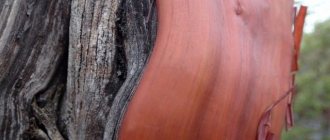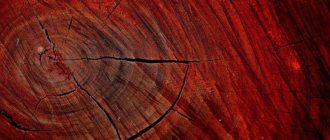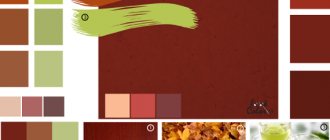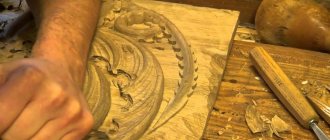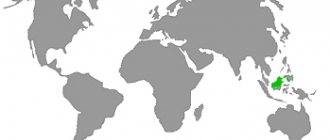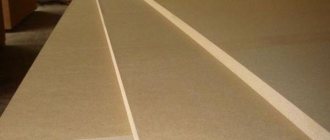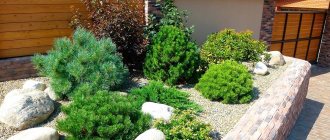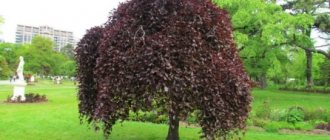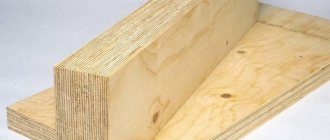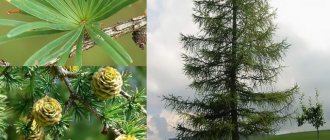Mahogany was first brought to the European continent by English sailors from Africa many centuries ago. Later it came to America. In those distant times, mahogany species were called “swallowtail” or “mahogony”. It received this name primarily because of its color - red-brown tones of varying intensity. In the 17th and 18th centuries, furniture made from this type was very popular among the nobility of those years. English aristocrats highly valued mahogany and furnished their homes with furniture from it.
After the emergence of the new neo-empire style in the 18th century, the prevalence of mahogany only grew. Currently, mahogany is also considered the preserve of only the rich; it is used for the production of furniture and interior decoration, although there is a high risk of purchasing a fake one. This article will describe what mahogany is, how it is grown, manufactured and how it differs from other species, as well as why it is so expensive. A couple of useful videos on the topic have been added, and the reader is also offered interesting material for downloading.
What is "mahogany"
This name refers mainly to ornamental and partly timber timber of a large tree from the genus Swietenia L., which belongs to the Meliaceae family. The only species included here, S. Mahagoni L., is what produces the well-known furniture wood. It is a significant tree with feathery leaves. Small flowers are bisexual, their stamens grow together into a tube; fruit box. Grows in Central America and the Westindies. Its heavy wood is red-brown in color. Another tree native to Senegambia and belonging to the same family is Khaya senegalensis, which is closely related to the fluorescent tree.
Question to the expert
What is mahogany?
Mahogany is a general name for a number of exotic wood species that have a similar structure, general quality characteristics and, of course, a noble, red-brown color of the wood.
These breeds traditionally include the South American Macare and Kaoba, the African Sapele, Kosilo, Iroko, Kaya and Sipo, as well as the representative of Southeast Asia - the Meranti. The most famous, “genuine mahogany” is called mahogany and grows in the tropical rainforests of Central America.
The lower varieties are “simple” wood (Madeira Mahagoni), without a pattern on the longitudinal section, and “striped”, obtained from the same wood when sawing parallel to the core rays, are the wood of Cedrela odorata L., C. guianensis Aubl. and S. Toana Roxb. Sw. (Khaya) senegalensis Desn. – the best variety (specific gravity - 0.91) and partly Soymida from Africa.
Cutting down a mahogany tree.
Logging
Europe learned about mahogany species during the period of great geographical discoveries and colonization. Since then, valuable wood has become an import item for European countries. It was always incredibly expensive. Trees of the above species grow very slowly - on average 2 cm per year; they do not form dense thickets, but grow rarely, at a certain distance from each other. Therefore, intensive deforestation has led to the fact that tropical forests are now greatly depleted in the species and types of mahogany. This set the goal for developed countries to preserve and increase plantings of valuable species. Currently, a number of countries have adopted laws regulating logging, which is also monitored by public organizations in a variety of ways, even by observations from a helicopter.
Types of mahogany
Almost all types of redwood are good for carpentry, but the most popular are yew, mahogany and amaranth. Mahogany wood is used for the production of office partitions, wall panels, and other interior items. Mahogany wood has a unique pattern - dark core rays that clearly stand out on the sawn surface. In addition, it is also very durable and perfectly tolerates high humidity - this quality allows the use of mahogany in shipbuilding.
Types of mahogany.
The first mention of mahogany dates back to 1595 and is found in the logbook of one of the British ships, on which this wonderful wood was used during repair work. By the beginning of the 21st century, mahogany confidently leads the list of valuable varieties, and this is due not only to its high aesthetic and performance properties, but also to a sharp decrease in the size of supplies, which does not fully satisfy the demand for the unique species.
What is bakelite plywood Balsam fir Why do you need a chisel Sugar maple wood
Mahogany is a tropical deciduous tree of impressive size. Its height can exceed the fifty-meter mark, the thickness of the trunk reaches two meters. Wood of this variety is usually used as a standard for the qualitative assessment of other species. In fact, some of its indicators may differ quite significantly for individual trees. Unscrupulous wood traders use this fact without hesitation, passing off so-called “false mahogany” species (eucalyptus, black alder and many others) as valuable mahogany.
Mahogany tree trunk.
Fresh cut mahogany usually has a yellowish color, which changes to a rich red over time. Mahogany wood comes in many shades, including brownish-red and dark crimson, grayish-red and copper-red, pale pink and purple-brown.
The dark core with clearly defined growth rings is bordered by narrow whitish sapwood. Barely noticeable core rays are arranged in tiers, forming an original pattern of horizontal, wavy lines on the sawn surface of the board. This wood pattern can serve as one of the criteria for determining the authenticity of mahogany wood.
Interesting read: Why boxwood was called a stone tree.
Wood of various types of mahogany differs not only in its variety of shades, but also in its grain pattern, which, by the way, along with other factors affects its cost. So, for example, mahogany has straight-grained wood, while representatives of the African branch usually have a twist, which gives a richer texture.
Smooth and patterned, striped and knotted, spotted and fiery patterns of the breed are known. The density of the wood ranges from extremely low (like soft tulip wood) to high - exceeding the density of oak. Natives from Africa (sipo, sapele, moss) have heavy and dense wood, which, however, is less biologically stable and more difficult to process than mahogany wood.
Mahogany trees.
Mahogany has the highest durability and is resistant to weathering, temperature fluctuations and high humidity. Products made from this wood do not change their shape and size over time. Mahogany is easily amenable to all types of carpentry and turning, sanded, polished, and glued.
READ Amazing poplar tree
One of the disadvantages of mahogany is its ability to “imprint” when in contact with surfaces made of lighter wood (coloring substances contained in the wood can transfer to them in places of contact).
Material on the topic: all about balsam fir wood.
Its noble shade adds elegance to even the most simple-shaped products. Latin American mahogany and Asian meranti have found the greatest use in the furniture industry.
The spectacular texture and soft warm color of mahogany are ideally suited for the exclusive decoration of interiors of houses and cabins of luxury yachts. In addition, durable wood is used to make musical instruments (pianos and grand pianos) and is actively used in shipbuilding.
The high demand for mahogany wood and the associated intensive logging have threatened the continued existence of the main species of mahogany. Fortunately, artificial regeneration of plantations helped to introduce its most valuable varieties in India and Sri Lanka, Brazil and the islands of Oceania.
Application in the national economy
Mahogany is used for the manufacture of first-class furniture, interior decoration, finishing of wall panels, and the production of expensive parquet.
Window and door frames made from these varieties are installed in royal palaces.
This wood is used to make inlays, carved decorations and figures, and mosaics. It makes excellent musical instruments.
Garden furniture made of yew or red sandalwood will decorate park alleys for many years.
Tiss
Yew berry was often used to decorate park areas. In favorable conditions, the plant can grow for a very long time - up to 4000 years, and tolerates cutting and replanting well at any age. Yew is a plant that is less demanding on climatic conditions, often found in Western Europe, the Caucasus and Asia Minor.
The peculiarity of the wood of this plant is its high bactericidal property and high strength. Its use by humans was quite extensive, which is why the plant was almost completely exterminated. Currently, yews are quite rare in natural conditions and are among the rarest plants on the planet.
Tiss.
Mahogany" is used for a group of different types of trees that differ in their special color and wood properties. They grow in the tropical latitudes of America, India, Africa and southeast Asia. The following types of mahogany are especially popular:
- mahogany;
- kerwing;
- merbau.
Each of them has its own characteristics and advantages.
Table of densities of wood of various species.
Mahogany
This type of mahogany is found in the Central American jungle. It is also known as American or Honduran mahogany. Its appearance is amazing: the plant reaches 60 m in height, the trunk diameter is approximately 2 m. Red-brown wood of different shades and densities is stored under a thin layer of bark.
Some specimens are quite hard, like red oak. Others have medium density and are equivalent to a regular chestnut. Mahogany supplied from Fiji is especially valued on the world market. There the tree is considered a national treasure.
Good to know: why a carpenter can’t do without a chisel.
The genus Switenia is a genus of evergreen plants, in which, according to various sources, there are from 5 to 8 species living in the New World (America, Antilles). Of these, three very closely related species have been known in Europe since the mid-17th century as mahogany and produce the most valuable wood. They are collectively called mahogany.
The first type of twisted mahogany (Switenia mahagoni), mahogany, mahogany or mogno, which has the best properties of wood, was studied and became known. This is a large tree: height - up to 30, and sometimes up to 45 m, trunk diameter - up to 2 m at the butt.
The leaves are small, pari-pinnate and elongated-pointed, with opposite leaflets. The flowers are small, the axils are collected in panicles. The fruit is a capsule. It grows abundantly in tropical rainforests, in lowlands and on low hills on moist, fertile soils, sometimes climbing into the mountains up to an altitude of 1200 m. It is widespread in the West Indies (Antilles).
Mahogany mahogany.
From the early to mid-twentieth century, mahogany reserves in the Caribbean islands were virtually destroyed. In the 60s and 70s, forest plantations were established on a number of islands, including Cuba (about 300 thousand hectares), the species was introduced by the British to the island. Sri Lanka and India. Switenia macrophylla or caoba is slightly inferior in quality to the first type of wood, but is much more widespread (Mexico, Ecuador, eastern Peru, central Bolivia, western Brazil, Colombia and Venezuela).
The species was introduced by the same British on the Fiji Islands, where currently more than half of the areas are ready for industrial development. A lesser known species is Switenia humilis. It grows in western and southern Mexico, El Salvador, Nicaragua and Costa Rica.
Material on the topic: Why does wood need fire protection?
Technical maturity of mahogany occurs at the age of 40-50 years. Switenia (mahogany) Jadrova, a diffusely vascular species with narrow white sapwood. The kernel is brown or brownish-red, with color of varying intensity. On a fresh cut from a growing tree, the wood has a flesh-pink color, which gradually darkens in air.
Product made of mahogany.
The cross section shows light boundaries of the annual layers. The medullary rays are narrow, poorly developed, and in a tangential section are located in horizontal rows or tiers. The vessels are quite large, collected two or three in small radial groups. The wood is mostly straight spherical. "Kaya" wood is similar in structure to mahogany wood, however, curling is often observed. The kernel ranges in color from pale pink to dark red-brown.
Sapeli, sipo and kosipo have denser and heavier wood. Light sapwood up to 10 cm wide is sharply separated from the core, often different in color from mahogany, but dark reddish or purple-brown color is also found. The vessels are smaller than in mahogany. Svitlovatisha fibers form a uniform striped pattern on a radial section.
African family
In Africa, two genera of the Meliaceae family grow. One of them is Kaya (Khaya) - a genus of evergreen trees growing in the tropical forests of Africa, on the Cape Verde Islands and on the island of Madagascar. The most common species - Khaya ivorensis (African Kaya, African mahogany, Kaya-mahogany, neallon, African kaoba) grows in the coastal zone of closed or high-stemmed moderately humid forests at the foot of the slopes, rising no higher than 800 m above sea level. Khaya anthotheka has a more limited range.
It is found mainly in the interior of the continent, in gallery forests and savannas. Known under the names Akazhu white (based on the color of the bark), Kaya twisted colorova, stole, muniama. These are large trees: with a height of 15 to 50 m and a diameter of 60 to 130 cm. In the Melievich family there is another African genus - Entadrophragma. Three of its species are also classified as African mahogany: sapeli (Entadrophragma cylinaricum, sipo (Entadrophragma utile) and cosipo (Entadrophragma condellei.
These species are widely distributed from Sierra Leone in the north to Angola and from the west coast of Zaire to Uganda. Just like Kaya, these are large trees with a straight cylindrical trunk, up to 45 m high and up to 2 m in diameter.
Amaranth
Amaranth is a plant that grows in Central and South America. The wood has a uniform texture and a beautiful, even pattern. Amaranths are very sensitive to sunlight, which is why the color of their wood can change and darken. Their most common use is in the manufacture of furniture, inlays and carvings. Amaranth wood lends itself well to processing, thanks to which it retains its natural shade even when painted and varnished.
READ Catalpa: unusual facts
Amaranth wood.
Another “red giant” will grow in South America - Amaranth. The tree reaches a height of approximately 25 m, with a maximum trunk diameter of 80 cm. If you carefully examine the cut of the tree, you can see the original design. It is obtained due to the chaotic interweaving of plant fibers. Interestingly, fresh sawn wood is colored gray-brown, which can change during the oxidation process. These colors can be:
- reddish;
- violet;
- black.
Amaranth wood is valued for its ease of processing, wear resistance and ability to restore color after removing the top layer.
Interesting to read: where are MDF panels used?
Keruing
The tree grows in the forests of Southeast Asia. Its height reaches 60 meters. The thickness of the trunk of an adult plant is almost 2 meters. Keruing's saw cut can be in the following shades:
- light beige;
- brown;
- dark brown.
At the same time, crimson or red inclusions are visible on it. Products made from this type of wood are particularly resistant to various chemicals and moisture. The main reason is the presence of rubber resins. This fact can be taken into account when purchasing products from keruing.
Keruing tree trunk.
Density: 750 – 850 kg/m3. Brinell hardness – 4.5. The fiber arrangement is usually straight, but may have a slight tangled curl. Wood from keruing is dense and 30% harder than oak. Due to the large amount of resins in wood, carving perfectly tolerates a variety of natural phenomena, high humidity and more. Due to its high density and hardness, this wood almost does not rot and is not spoiled by pests. Wood from keruing has a high modulus of elasticity. That is why wood is actively used not only for the construction of terraces, piers and finishing the facades of buildings, but also in the production of furniture, shipbuilding, etc.
Keruing has a pronounced texture and, as a rule, a straight distribution of wood fibers (this explains its high density). It is strongly recommended to treat the wood with special products to avoid unnecessary release of resins. The wood structure of keruing is distinguished by the rich color of mahogany. The wood itself comes in a wide range of colors, from beige to maroon and red, sometimes with purple tongues. Very often found in dark brown color. The sapwood is grayish-brown and distinct. The texture is pronounced. The darker the wood, the stronger it is.
Harvested wood keruing.
The content of rubber resins in wood adds moisture resistance and acid resistance, although they create some difficulties during processing. Keruing is high-quality wood, optimal in price and high technical performance. Due to its high qualities, Keruing has a fairly wide range of applications. Its wood is used in production:
- various products;
- parquet;
- cladding;
- shipbuilding
- furniture
- in construction
Teak
This mahogany tree grows throughout the African continent and southeast Asia. Its wood has a uniform golden color and is characterized by the following properties:
- high strength;
- resistance to changing external factors;
- ability to withstand strong mechanical loads;
- durability.
The material is used for the manufacture of various types of furniture, in the construction of buildings and ships.
Yacht deck made of teak.
Characteristics of wood
Mahogany has a number of unique qualities that make wood an elite, expensive raw material:
- lends itself very well to various types of manual and machine processing - cut, glued, painted, varnished without compromising natural shades;
- perfectly polished;
- dries well;
- is highly resistant to erosion;
- durable;
- extremely wear-resistant;
- has high impact resistance;
- practically does not deform, products retain their shape for many decades,
- wood is highly elastic;
- resistant to moisture and chemicals;
- not damaged by pests - termites, wood bugs, and also not affected by fungal mold;
- withstands any adverse weather conditions without succumbing to the harmful effects of sun, rain and wind.
Such characteristics make this wood a favorite raw material for cabinetmakers - experienced, skilled craftsmen. Mahogany products are valued extremely highly.
Unique merbau tree
The merbau decking board is known all over the world for its amazing properties, and in the plant world the merbau tree is considered unique. Its wood is very dense and hard and does not react to moisture. The tree grows in countries with a warm and humid climate - on the island of New Guinea, in Southeast Asia. Beautiful natural shades - golden-burgundy, chocolate, bright brown and fawn - make it possible to create true masterpieces when carrying out finishing work.
Terrace board made of merbau wood.
The ancient inhabitants of the island of Feji believed that merbau had a sacred origin, and various magical properties were attributed to it. Modern inhabitants of the island even now compare a person of unusually strong will to this tree. Cut merbau has an even and rich range of shades:
- light beige;
- brown;
- dark brown;
- chocolate.
Against this background, the golden veins stand out brightly, which looks truly beautiful. The material is resistant to insects, various fungi and changes in humidity.
Merbau tree.
Nutmeg
Nutmeg is the core of the fruit of the nutmeg tree. The kernel is gray-brown, uneven, oval in shape; in cross-section you can see a marble pattern. The taste of the nut is slightly pungent, even islandy, but slightly sweet with an admixture of earthy notes. The smell is pleasant, spicy-nutty and sweet.
Useful properties: Used to treat impotence, increases sexual desire, is considered an aphrodisiac; prevents viruses from spreading throughout the body and has an anti-inflammatory effect.
Contraindications: Abuse can cause indigestion and poisoning; eating the nut is also prohibited for hypertensive patients and people with individual intolerance.
Properties of merbau wood: does not sink in water, cannot be destroyed
Many consider merbau to be the most durable tree in the world, which is indestructible. Properties of wood such as:
- The unique beauty of the texture (a special fiber pattern and amazing shades - from burgundy to milk chocolate - open up wide application possibilities).
- High density.
- Durability (higher than other breeds).
- Hardness – far exceeds the hardness of solid oak. Resistance to various mechanical influences.
- Not susceptible to moisture, insect pests or rotting. Merbau has proven itself excellent in the design of swimming pools, decks, mooring structures, and beach areas.
- The ideal surface of the merbau decking board, which is a perfectly smooth coating, without any flaws.
- Durability (classified 1-2, longer than other breeds that grow in South Asia). Over the years it only becomes stronger; the service life of wood products is unlimited.
These properties are due to the density of red wood.
Table of densities of wood of various species.
Yew wood
Yew is a small tree; The berry yew reaches a height of 30 m, and the pointed one - 15 (20) m and up to 1 m in diameter. But such sizes are observed in the oldest trees growing in the most favorable conditions. In practice, there are yews 10-12 in height, and sometimes in the form of bushes. The crown is often sharp, low-hanging, and very dense. The trunk is irregularly shaped, sometimes ribbed. The bark is thin, reddish-brown, and in old trees peels off in long thin strips. The needles are single, relatively wide, dark green on top, shiny, arranged in two rows on the shoots, very dense, soft.
The seed is ovoid, about 8 mm in diameter, with a hard dark brown shell, almost entirely enclosed in a bright red or pink apex. This is not a berry, but a modified cone, like other conifers. Here I would like to suggest to those who like to put various twigs, blades of grass and needles in their mouths: do not do this with yew - its needles are poisonous! But the pink, sweetish auricles are edible and contain no poison.
Yew tree.
Yew is the most shade-tolerant species; at a young age, yew can grow in conditions of the strongest shading. In green buildings it also grows in full light, but in trees suddenly exposed to light (after removing neighboring trees in the forest), shoots form on the trunks from dormant buds. The best grows in well-drained, fertile soils. Frost-resistant and wind-resistant. There is a lot of data in the literature about the very slow growth of yew and its long life expectancy (up to 3000 years).
It is difficult to check this, since old trees usually have a large hollow inside. The age we calculated for trees 50 cm in diameter on a stump did not exceed 300 years, and the height of 5-year-old plants was 80 cm.
Yew is very decorative: bright dark green needles, bright red or pink shoots; You can give its crown any shape with a haircut. All this makes yew indispensable in decorating various squares, boulevards, parks and squares. Especially many yews are planted in resorts and sanatoriums of the Black Sea coast. Yew is also used for landscaping in other places, but is still very rare. It is much more beautiful than blue spruce.
Young yew trees.
Collection, processing and storage
How are Indian nuts collected?
- The stalk of the Indian nut is removed from the tree in the same way as is done with an apple or pear.
- Then the fruit itself is manually separated from the pulp.
How are kernels extracted from the shell?
Important!
Cashews are never sold unpeeled for the reason that the shell, as well as the resinous film between the shell and the shell, contains caustic toxic substances - cardol and anacardic acid.
When they get on the skin, they cause irritation and even burns, and can cause swelling of the larynx and suffocation.
- When cleaning the fruit, wear rubber gloves to protect your hands from damage.
- Put a protective mask on the face to protect against respiratory tract damage.
- Cashews are roasted before peeling to make the process safer. At high temperatures, toxic substances evaporate, and the shell is easily removed after such treatment.
- The shelled kernels are again subjected to short-term heat treatment so that the remaining caustic resin evaporates and the inner shell is easily removed.
How to store the product?
- Store peeled nuts in a glass container in the refrigerator for 2 months.
- It is permissible to freeze raw nuts, but the shelf life should not exceed one year.
Indian nut will bring undoubted benefits to men and women, children and adults, if consumed in moderation and following precautions
It is also worth paying attention to the fact that the exotic nut has much more beneficial properties than harmful ones.
Peanut
Peanuts are considered groundnuts. The rough, wrinkled pods look like beans, with a web-like pattern on the shell. The kernel is oblong, oval, up to about 20 mm in size, the film is thin, easy to clean. The nut has a sweet taste and a hard consistency.
Beneficial properties: Regular use stimulates the functioning of the heart muscle and brain, reduces the risk of developing heart disease, removes waste and toxins, suppresses excessive appetite and normalizes gastric secretion, restores reproductive function.
Contraindications: Peanuts are contraindicated for obese people, with impaired functioning of the pancreas and intestines, as well as for children under 3 years of age. Overeating can cause allergies and even severe intoxication.
Pine nuts
Pine nuts are the well-known pine nuts, but about 4 times larger. This is a coniferous tree that grows in Italy, the seeds are formed in cones. The shell is dark brown in color, with whitish specks, very durable. The taste of the nut is delicate, with a slight aroma of resin.
Beneficial properties: Useful for healing wounds and cuts, for intestinal problems, heart ailments, skin allergies, bronchitis and cough. They are a diuretic and, according to some data, increase potency in men and activate sperm.
Contraindications: Allergies and individual intolerance. Consumption by children under 3 years of age, pregnant women and nursing mothers.
Beneficial features
Brazil nuts are an excellent preventive remedy that helps prevent the development of many diseases and reduce the manifestations of existing pathologies.
Inflammation suppression
One of the most pronounced beneficial properties of Brazil nuts is its ability to suppress inflammatory processes. This effect is due to the presence in its composition of a substance called ellagic acid. Since it has pronounced anti-inflammatory properties, the nut is recommended for use for sore throat, bronchitis, prostatitis, cystitis, and adnexitis.
However, you need to remember that you cannot use it as an independent medicine, ignoring the medications prescribed by your doctor.
Fight obesity
Despite their high calorie content, nuts are useful for people who want to lose weight.
Nutritionists recommend including them in your diet instead of cakes, chips, fatty meats or fried potatoes. The listed products contain much less nutrients compared to Brazil nuts. In addition, it contains polyunsaturated acids necessary for converting white fat into brown fat. The latter is used by the body for energy and ensures effective fat burning.
Normalization of thyroid function
For normal functioning of the thyroid gland, you need not only iodine, but also selenium, which takes an active part in the production of important hormones. Selenium deficiency in the body can cause the development of hyperthyroidism and other thyroid disorders
It is especially important to supplement selenium in women, as they are more susceptible to thyroid disease.
Maintaining men's health
The large amount of selenium in Brazil nuts has a beneficial effect on the male reproductive system. This microelement is found in the testicles and spermatic cords, and its deficiency in the body leads to dysfunction of these organs and a decrease in the quality of sexual life.
Selenium and zinc are necessary for the production of the male hormone testosterone. Its lack in the body can cause a decrease in libido, replacement of muscle mass with fat, and the development of chronic depression.
Mental stimulation
Selenium, phosphorus, magnesium, potassium, calcium, antioxidants and omega-3 fatty acids saturate brain cells with energy, which transmits nerve impulses. Brazil nut helps cleanse blood vessels and improve the supply of blood and nutrients to the brain. Thanks to this, memory improves, mental activity and concentration increase.
Eating several kernels throughout the day helps prevent mental and emotional fatigue, improve mood and mental state.
Strengthening bones and teeth
Due to the high content of phosphorus, potassium, calcium, copper and amino acids, Bertoletta kernels help accelerate the fusion of bone tissue. Therefore, it is recommended to use it during the healing of fractures. This product is also useful for rheumatoid arthritis, joint stiffness, and osteoarthritis. It improves metabolism in bone and joint tissues, normalizes the production of joint fluid, and also improves the condition of teeth.
Prevention of cancer
In studies conducted on animals, it was found that selenium has the ability to stop the growth of malignant tumors. And since the nut also has pronounced antioxidant properties, its regular consumption reduces the likelihood of developing malignant tumors.
Reducing cholesterol
Brazil nuts are an excellent remedy for combating high cholesterol levels. Its use reduces the risk of blood clots and the development of heart and vascular diseases.
Origin of the name Edit
Cashew tree in Brazil, near Fortaleza.
The Latin name comes from the Greek word kardia.
- the heart, since the so-called apple (false fruit) has a similar shape to it.
Cashews are easy to cultivate, which was successfully used by the Tikuna Indians living in the territory of modern Brazil. They used the bark, leaves, and fruits of the tree for a variety of purposes, not only culinary. In the Tikuna language, cashew is called acaju
(meaning “yellow fruit”).
The name in Portuguese “caju” (port.caju) or “acajou” (port.acaju) comes from a word in the Tupiacayu language [2], the components of which have the following meanings: a
– fruit;
´ ác
– which connects;
aiú
– fibrous; that is, a fruit that consists of fibers; fibrous fruit. The French traveler Andre Theve, in his description of Antarctic France, called the tree and nut “acaiu” or “acaiou” (French Acaïou) [3]. The Indians of Brazil counted a person's age by the times of flowering or harvesting, so they associated the word “caju” with the concept of “year of life” (port.ano de vida), and this meaning was preserved in the Brazilian version of spoken Portuguese in informal communication [2]. It is from the Portuguese names of the fruit “caju” and the tree itself “cajueiro” (port.cajueiro) that in turn came the English name “cashew” (English cashew), borrowed into the Russian language.
However, in Venezuela cashew is better known as merey
, and in many other Spanish-speaking countries of Latin America as
marañón
, after the name of the state of Maranhão (port. Maranhão) in northern Brazil, where the cashew tree was discovered. In Mozambique, the names “mecaju” (port.mecaju) and “mepoto” (port.mepoto) are known.
Other synonymous names that are used in different countries and in different languages: cashu, casho, acajuiba, acajou, acajaiba, alcayoiba, anacarde, anacardier, anacardo, cacajuil, cajou, gajus, jocote maranon, noix d'acajou, pomme cajou, pomme jambu, jambu golok, jambu mete, jambu monyet, jambu terong, kasoy, ouja
(in Arabic عوج is the plural of the word أعوج - “dent”, “crook”).
Description Edit
Botanical illustration from Köhler's Medizinal-Pflanzen
, 1887
Anacardium occidentalis is a small evergreen tree 10-12 m high, with a short, often irregularly branched trunk.
The crown is wide-spreading, its diameter is comparable to the height of the tree - 8-10 m.
The leaves are alternate, leathery, elliptical or ovate, entire, 4–22 cm long and 2–15 cm wide.
The flowers are pale green, transitioning to reddish, with five thin pointed petals 7-15 mm long; collected in a panicle or shield up to 26 cm long.
What is often called the cashew fruit, or “cashew apple,” is actually an overgrown juicy stalk, or, more correctly, a receptacle (receptacle). They are yellow or red, 5-11 cm long, pear-shaped or diamond-oblong in shape. Hidden under the skin is a yellow, fibrous, very juicy, slightly astringent, sour-tasting pulp. Botanists call such formations “pseudofruit”.
The true cashew fruit develops at the very end of the stalk, after the pseudo-fruit “apple”. This is a nut that resembles miniature boxing gloves. It is covered with a double shell. The outer one is green and smooth, containing a caustic phenolic resin. The inner one looks like a dense shell, covered with honeycomb-like cells, under which lies the edible kernel of the nut, similar in shape to a human kidney.
The average weight of one nut is 1.5 g.
How the nut is collected and processed
Fruits suitable for consumption must be fully ripe. However, already 2 days after ripening they begin to deteriorate. Therefore, in order to prevent damage to the crop, it is harvested every day. Most often this is done manually.
Ripe fruits fall from the tree to the ground, where they are picked up by workers. Afterwards, the nut is separated from the apple and peeled. To prevent the caustic juice from damaging the skin, collecting and cleaning cashews is carried out wearing protective gloves, but this is not always the case.
Depending on the technical equipment, shells at processing plants can be removed either mechanically or manually, using special tools.
Help: Unlike most other types of nuts, cashews are never sold in shells.
The nut production technology is as follows:
- First, the collected nuts are heat treated to remove any remaining caustic resin from the kernels.
- Afterwards, the fruits are dried in the open air or in special drying chambers to remove excess moisture from them.
- Then the dry kernels are shelled.
- Next, the peeled cashews are calibrated by size.
- They are then packaged and sent for sale or to other production facilities for subsequent processing.
